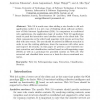Free Online Productivity Tools
i2Speak
i2Symbol
i2OCR
iTex2Img
iWeb2Print
iWeb2Shot
i2Type
iPdf2Split
iPdf2Merge
i2Bopomofo
i2Arabic
i2Style
i2Image
i2PDF
iLatex2Rtf
Sci2ools
KSEM
2010
Springer
2010
Springer
A SOM-Based Technique for a User-Centric Content Extraction and Classification of Web 2.0 with a Special Consideration of Securi
Web 2.0 is much more than adding a nice facade to old web applications rather it is a new way of thinking about software architecture of Rich Internet Applications (RIA). In comparison to traditional web applications, the application logic of modern Web 2.0 applications tends to push the interactive user interface tasks to the client side. The client components on the other hand negotiate with remote services that deal with user events. The user should be assisted in different scenarios in order to use the existing platforms, share the resources with other users and improve his security. In this paper we present a user-centered content extraction and classification method based on self-organizing maps (SOM) as well as a prototype for provided content on Web 2.0. The extracted and classified data serves as a basis for above mentioned scenarios.
| Added | 14 Feb 2011 |
| Updated | 14 Feb 2011 |
| Type | Journal |
| Year | 2010 |
| Where | KSEM |
| Authors | Amirreza Tahamtan, Amin Anjomshoaa, Edgar Weippl, A. Min Tjoa |
Comments (0)

